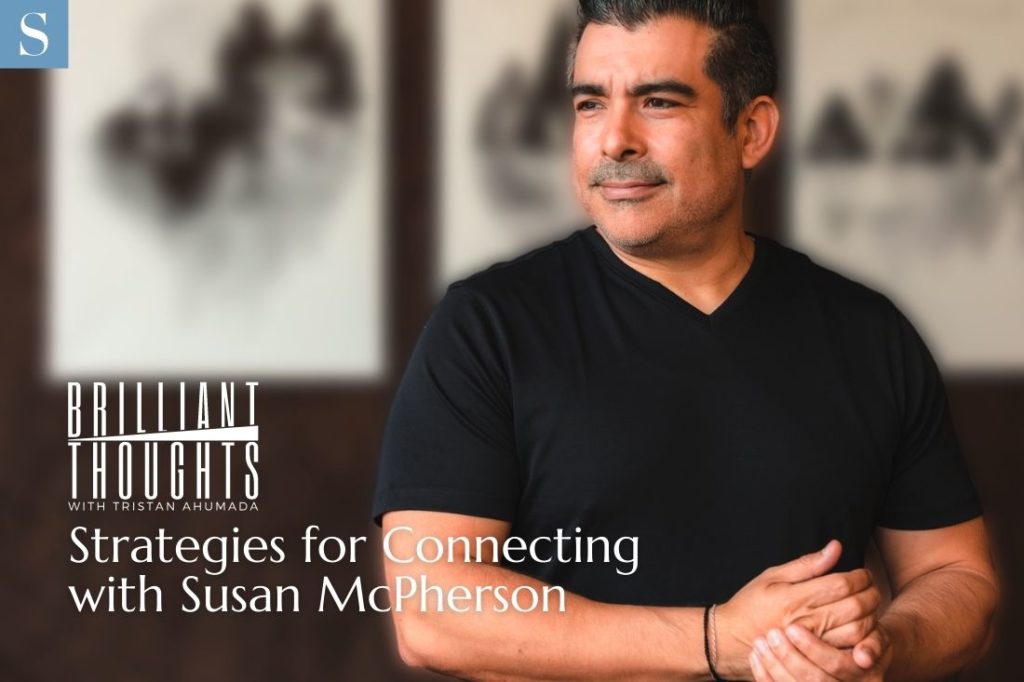In 2018, only 53% of Americans said they had meaningful interactions with other people. The revelation came from a study fielded by Cigna, in which 20,000 adults were surveyed about their daily interactions. The goal of the study was to measure how lonely or isolated people felt. Each respondent was given a loneliness score and by the end of the study, Cigna determined that most U.S. adults are very lonely.
Now place this reality inside of everything life demands of us—working on business teams, introducing ourselves to new people and asking them to invest in our dreams. If we’ve lost the ability to truly connect, as the study suggests, how can we accomplish those things?
In this episode of Brilliant Thoughts, SUCCESS People Editor Tristan Ahumada talks with Susan McPherson, author of The Lost Art of Connecting: The Gather, Ask, Do Method for Building Meaningful Business Relationships. They dissect McPherson’s sales career and how she forms meaningful yet advantageous relationships.
“I learned the importance of reaching out to people but not when you needed something,” McPherson says. “In other words, just checking in for the sake of checking in. So that maybe when it was time to ask them for their business or buy something, there was already a meaningful relationship.”
It takes just three intentional acts to spark a connection. Keep reading to learn McPherson’s technique of gathering information, asking questions and doing what it takes to nurture new bonds.
Step 1: Gather
We’re still in a pandemic, but people are itching to go out and meet new people. Before things go back to normal, check in with yourself. Gather some information about the individual relationships you want to build.
“We are in this unique space,” McPherson says. “I almost liken it to purgatory. We can see it, we can feel it, but we’re not there yet. We know we are somewhat going to be coming out—not all of a sudden, not zero to 60—but we are going to have some sense of normalcy…. What a perfect opportunity to look inside ourselves and actually think, ‘What is that community that is going to help me meet my goals?’”
Here are four things to consider as you look within:
- What does a meaningful connection look like to me?
- What type of community should I build to achieve my goals?
- How can I make sure my community is diverse?
- What can I offer to the people in my community?
If you already know who you want to connect with, start gathering more information. Visit that person’s website and learn about their business. Make a mental note of the accomplishments they post on social media. All of this information will come in handy during your first in-person meeting.
Step 2: Ask
Asking for what you want is an underrated skill. Those who do it well understand that most people ignore random requests. If you want to become a part of someone’s life—and get what you want at the same time—you have to be a good listener. Identify the challenges they struggle with so you can become a problem-solving resource.
McPherson learned this trick from her first boss, Nancy Sells, in 1989. They worked together at PR Newswire, and during that time, McPherson learned how to sell herself to others.
“What [Nancy] taught me was, it wasn’t about selling,” McPherson says. “It’s about understanding what’s important to other people and then helping solve problems or helping them realize their dreams and goals. So, in other words, you’re not pushing anything. You’re basically just allowing them to fulfill [their dreams].”
When you first meet someone, save your requests for later. Focus on building the relationship as you continue to add value to that person. Once you’ve laid a good foundation, you can make a request without overwhelming your new contact.
This is the perfect time to use the information you learned in the “gather” stage. When you meet for the first time, mention the new book they’ve written or the award they’ve just won. Maybe you can lend your expertise to that person’s next goal.
Step 3: Do.
So you’ve gathered information and made your unconventional, not-so-selfish ask. Now it’s time to take action. As you make connections, the next step is keeping your word, or in other terms, acting on the subtle promises you’ve made. If that means calling someone within three days, be sure to set an alarm or add a reminder to your calendar.
In the “do” stage, it’s better to connect rather than network. You don’t want to take the “business event” approach, where you meet dozens of people and try to build relationships with all of them.
A better option, McPherson says, is practicing the power of three when you walk into any room:
- Meet three people.
- Learn three things.
- Share three things.
“That, to me, sounds much more meaningful than grabbing 20 business cards, and then maybe connecting with 15 of them on LinkedIn,” McPherson says. “And not having any idea what their names are.”
Brilliant Thoughts with Tristan Ahumada is no longer releasing new episodes on the SUCCESS Podcast Network, but you can still listen to the full conversation below.












